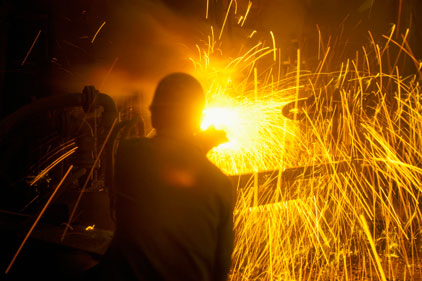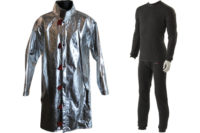The reality is that not all FR protective gear provides the same level of protection, and performance varies greatly from FR-treated materials that typically provide minimal protection to high-performing fabrics constructed of truly non-flammable fiber blends.
The bulk of the protective clothing solutions on the market today are categorized as flame resistant, fire resistant, FR, flame retardant or fire retardant, although the latter two terms are often used to describe a chemical substance that imparts flame resistance on a fabric. Flame resistance may be achieved by using fibers that have this property inherently in the polymer or by applying a chemical finish to a fabric. If a fabric is inherently flame resistant, its thermal protective properties will not wash out or wear way.
The most defining characteristic of a FR fabric is that it doesn’t support combustion in the absence of an external flame source. FR products ignite with difficulty, burn slowly when set on fire, and most importantly, self-extinguish when the heat source is removed. Some FR fabrics off-gas to prevent combustion and may char or break open after exposure.
On the high-end of the spectrum are non-flammable, fire-proof, and non-combustible products. While FR protective clothing won’t contribute to a burn injury in a thermal exposure, making a bad situation worse, non-flammable apparel will actually protect a wearer in a thermal event. These solutions go above and beyond industry standards in providing a persistent thermal barrier with minimal heat conductivity. They will not burn, melt or ignite, and they maintain their strength and integrity even after intense exposure.
Measuring flame resistance
The term flame resistant or FR is used to describe a wide variety of treated and inherently resistant materials that can vary significantly in their levels of performance. However, there are several widely accepted tests to measure a protective fabric’s flame resistance and help safety managers in their PPE decision-making.
The most commonly used test method for measuring flame resistance is the Vertical Flame Test outlined in ASTM D6413 Standard Test Method for Flame Resistance of Textiles. This test method determines the response of textiles to a standard ignition source. A 12-inch by 3-inch swatch is hung vertically in the test chamber. The bottom of the fabric is exposed to a standard flame for 12 seconds and then the flame is extinguished. After the flame is extinguished, the duration of after flame and after glow are calculated.
The swatch is then removed from the chamber and a weight is attached to one corner of the fabric. The fabric is lifted by the opposing corner. The fabric tears along the line that was degraded by the flame. The resulting tear is called the char length. The shorter the char length, the greater the fabric’s ability to withstand exposure to flame and protect the wearer.
While there are no pass/fail requirements in the vertical flame test, industry-established standards range from 4-inch to 6-inch (100 mm to 150 mm) maximum char lengths and two seconds or less after flame and after glow.
The vertical flame resistance, as determined by this test method, only relates to a small, specified flame exposure and relatively short application time. This test method maintains the specimen in a static, draft-free, vertical position, and does not involve movement except that resulting from the exposure.
True protection from thermal events is better measured in dynamic environments, where movement and exposures to simulated hazards can be accounted for.
Flammability metrics
Other good measures of flammability in a protective fabric are the Limiting Oxygen Index, flash fire exposure, and Thermal Protective Performance.
Limiting Oxygen Index. The Limiting Oxygen Index measures the amount of oxygen required in the environment for a fabric to support combustion. Any material with a LOI rating less than 20.95 (the oxygen volume of air) will burn in air. For example, the LOI rating of cotton is 19. Modacrylic fabrics have a LOI rating of 26, while para-aramid fabrics have a LOI rating of 30. Carbonized fiber blends, which expand when exposed to intense heat and flame and eliminate any oxygen content within the fabric, have a LOI rating of 55, nearly three times that of air.
Flash fire exposure. Many FR products meet industry-established requirements for protecting against a three-second flash fire exposure, but there are non-flammable options on the market that can protect for as long as 10–15 seconds without breaking open. A few extra seconds to remove clothes or put out a fire can make a big difference in the degree and extent of a burn injury.
Thermal Protective Performance. Thermal Protective Performance (TPP) is a measurement of a protective fabric’s thermal insulating performance against convective and radiant heat. A fabric’s TPP score is simply two-times the number of seconds it takes for a second-degree burn to occur when exposed to a 2.0 cal/cm2 flame. The higher the TPP rating, the higher the level of protection.
Ability to protect against multiple hazards. Another important consideration is a protective fabric’s ability to protect against molten metal, petrochemicals, hot/flammable liquids, arc flash, etc. Not all FR protective clothing can withstand the variety of hazards that may exist within one facility. Modacrylic fabrics, for example, off-gas to prevent combustion, but they offer little to no protection against molten metal splash and are prone to break open after brief exposure to flame. Non-flammable protective fabrics are often multifunctional and designed to protect against numerous types of hazards in one single garment.
Whether categorized as flame resistant or non-flammable, the end goal of all PPE is the same: protect the wearer from getting burned and increase the chance of survival in a worst-case scenario. When selecting PPE, evaluate all of your options to determine which solution is most likely to deliver this result.



